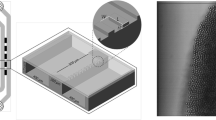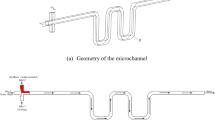Abstract
Although many aspects of microchannel emulsification have been covered in literature, one major uncharted area is the effect of viscosity of both phases on droplet size in the stable droplet generation regime. It is expected that for droplet formation to take place, the inflow of the continuous phase should be sufficiently fast compared to the outflow of the liquid that is forming the droplet. The ratio of the viscosities was therefore varied by using a range of continuous and dispersed phases, both experimentally and computationally. At high viscosity ratio (η d/η c), the droplet size is constant; the inflow of the continuous phase is fast compared to the outflow of the dispersed phase. At lower ratios, the droplet diameter increases, until a viscosity ratio is reached at which droplet formation is no longer possible (the minimal ratio). This was confirmed and elucidated through CFD simulations. The limiting value is shown to be a function of the microchannel design, and this should be adapted to the viscosity of the two fluids that need to be emulsified.







Similar content being viewed by others
References
Anna SL, Bontoux N, Stone HA (2003) Formation of dispersions using “flow focusing” in microchannels. Appl Phys Lett 82:364–366
Garstecki P, Gitlin I, DiLuzio W, Whitesides GM, Kumacheva E, Stone HA (2004) Formation of monodisperse bubbles in a microfluidic flow-focusing device. Appl Phys Lett 85:2649–2651
Garstecki P, Fuerstman MJ, Stone HA, Whitesides GM (2006) Formation of droplets and bubbles in a microfluidic T-junction—scaling and mechanism of break-up. Lab Chip 6:437–446
Kawakatsu T, Kikuchi Y, Nakajima M (1997) Regular-sized cell creation in microchannel emulsification by visual microprocessing method. J Am Oil Chem Soc 74:317–321
Kobayashi I, Nakajima M, Chun K, Kikuchi Y, Fujita H (2002) Silicon array of elongated through-holes for monodisperse emulsion droplets. AIChE J 48:1639–1644
Kobayashi I, Mukataka S, Nakajima M (2004) CFD simulation and analysis of emulsion droplet formation from straight-through microchannels. Langmuir 20:9868–9877
Kobayashi I, Mukataka S, Nakajima M (2005) Novel asymmetric through-hole array microfabricated on a silicon plate for formulating monodisperse emulsions. Langmuir 21:7629–7632
Lucassen-Reynders EH, Kuijpers KA (1992) The role of interfacial properties in emulsification. Colloid Surf 65:175–184
Rayner M, Trägårdh G, Trägårdh C, Dejmek P (2004) Using the surface evolver to model droplet formation processes in membrane emulsification. J Colloid Interface Sci 279:175–185
Saito M, Yin L-J, Kobayashi I, Nakajima M (2005) Preparation characteristics of monodispersed oil-in-water emulsions with large particles stabilized by proteins in straight-through microchannel emulsification. Food Hydrocolloid 19:745–751
Sasaki M, Yasunaga T, Tatsumoto N (1977) Kinetic studies on double relaxation of surfactant solutions using a capillary wave method. Bull Chem Soc Jpn 50:3144–3148
Steegmans MLJ, Schroën K, Boom RM (2009) Characterization of emulsification at flat microchannel Y junctions. Langmuir 25:3396–3401
Sugiura S, Nakajima M, Seki M (2002) Effect of channel structure on microchannel emulsification. Langmuir 18:5708–5712
Sugiura S, Nakajima M, Oda T, Satake M, Seki M (2004) Effect of interfacial tension on the dynamic behavior of droplet formation during microchannel emulsification. J Colloid Interface Sci 269:178–185
van der Graaf S, Steegmans MLJ, van der Sman RGM, Schroën K, Boom RM (2005) Droplet formation in a T-shaped microchannel junction: a model system for membrane emulsification. Colloids Surf A 266:106–116
van Dijke KC, Schroën K, Boom RM (2008) Microchannel emulsification: from computational fluid dynamics to predictive analytical model. Langmuir 24:10107–10115
Vladisavljević GT, Kobayashi I, Nakajima M (2008) Generation of highly uniform droplets using asymmetric microchannels fabricated on a single crystal silicon plate: effect of emulsifier and oil types. Powder Technol 183:37–45
Vlahovska PM, Danov KD, Mehreteab A, Broze G (1997) Adsorption kinetics of ionic surfactants with detailed account for the electrostatic interactions. J Colloid Interface Sci 192:194–206
Xu Q, Nakajima M (2004) The generation of highly monodisperse droplets through the breakup of hydrodynamically focused microthread in a microfluidic device. Appl Phys Lett 85:3726–3728
Acknowledgments
This research project is part of the Microdruppels project, in which we collaborate with Nanomi, FrieslandCampina, and Demcon amongst others. The project is financially supported by the Dutch Ministry of Economic Affairs and the Dutch provinces of Gelderland and Overijssel. Koen van Dijke and the Food Process Engineering group of Wageningen University want to thank the National Food Research Institute and the University of Tsukuba for their hospitality and willingness for cooperation.
Author information
Authors and Affiliations
Corresponding authors
Rights and permissions
About this article
Cite this article
van Dijke, K., Kobayashi, I., Schroën, K. et al. Effect of viscosities of dispersed and continuous phases in microchannel oil-in-water emulsification. Microfluid Nanofluid 9, 77–85 (2010). https://doi.org/10.1007/s10404-009-0521-7
Received:
Accepted:
Published:
Issue Date:
DOI: https://doi.org/10.1007/s10404-009-0521-7




